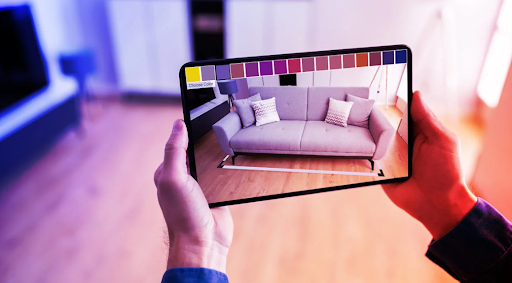Mar 14, 2024
tech,
AI
From Sci-fi to Reality: Top 3 Technologies Retailers Should Use Now
The rapidly evolving landscape of e-commerce is thriving with tech and innovations.
Imagine if you told the most ardent e-commerce enthusiast just a few years ago that sales figures would jump by 25%, and virtually everyone would buy online. We bet he would not believe it.
The truth is that’s already happening, and everything boils down to the ease of use.
Machine Learning and AI are no longer futuristic concepts. These are tools savvy retailers have in the arsenal to streamline operations, personalize customer experiences, and drive sales.
With the numerous benefits of using new technologies in e-commerce, the question arises: how to improve your e-commerce business with Innovation Feel?
Join us on a journey into the world of e-commerce innovation and the latest tech trends.
Let’s rewrite the rules of retail!
Artificial Intelligence and Machine Learning
Artificial Intelligence has become a buzzword in the realm of e-commerce evolution. Both Artificial Intelligence and Machine Learning empower businesses to analyze vast amounts of data and derive actionable insights. Software development and mobile apps fueled with AI can optimize routine tasks and streamline operations, increasing efficiency and productivity across various aspects of e-commerce.
Let’s delve into specific Innovation Feel e-commerce solutions and learn how these new technologies are revolutionizing the online shopping experience:
- Personalized Recommendations
With the help of AI innovation, businesses can analyze customers' browsing and purchasing history. This allows them to provide personalized product recommendations, focusing on each customer individually and giving the feeling of importance and care. Such a personalized approach increases the likelihood of both the purchase and customer return.
Example: Amazon and Spotify are the most iconic examples of personalized recommendations in e-commerce. Remember the time when you last used these services? You navigate to the platform and see the product you want appearing on your homepage in a somewhat magical way. This wow feeling strikes then: “How do they know I need this?”
With the help of clustering algorithms, the platforms can group similar products or customer segments. This allows them to identify items likely to be purchased together. Bought a camera recently? Maybe need compatible lenses or memory cards? Yes, this is definitely a win-win for both parties.
Catching fact: Amazon reports that 35% of its sales come from its recommendation engine.
- Predictive Analytics
The beauty of using AI and ML is that you can focus on the past, present, and future. For example, retailers use smart algorithms to predict future sales trends and adjust their strategies accordingly, reducing stockouts and overstocking.
Example: Retailer giants like Walmart analyze historical sales data, customer demographics, weather, and external factors that might influence demand, like economic indicators. With remarkable accuracy, Walmart anticipates demand for specific products. For example, intelligent systems might reveal a strong correlation between sunscreen purchases and rising temperatures.
Also, by predicting future demand for specific products at individual stores, Walmart can ensure they have the right amount of stock on hand. The company's use of AI and predictive analytics has already helped it reduce out-of-stock items by 50%.
Wanna to learn how super apps affect traditional business models? Reach out to this blog post!
- Chatbots for customer service
AI-driven chatbots could be a helpful assistance to your company, providing instant support and guidance to customers around the clock. These chatbots handle routine inquiries, resolve issues, and streamline the customer service process, freeing up human agents to focus on more complex tasks.
Example: eBay uses chatbots to handle routine customer queries. The chatbots can understand basic questions and respond through text or voice interactions. Virtual support does not sleep, so there are no frustrating wait times. There is also no need for holidays or days off. Your clients can benefit from your service anytime!
Augmented Reality and Virtual Reality
AR and VR are no longer the stuff of the distant futuristic future. According to recent research, the global VR market will reach $21.5 billion by 2025, so the new technological era is definitely behind these highly-scaled new technologies in e-commerce.
Most know VR and AR from their gaming experiences. But the reality is far more than entertainment. For example, imagine the typical history lesson. With AR and VR, students can step back in time and witness big historical events firsthand. They would be able to walk through virtual recreations of ancient Rome and interact with museum exhibits from their own homes.

So, hold onto your headsets, we will explore the most advanced ways of utilizing AR and VR technologies.
- Virtual try-ons
A study conducted by ModeFace says that AR try-on experiences can increase conversion rates by up to 200%. What's driving this trend? Augmented Reality is the easiest way to see whether the product fits you or not. With the help of Augmented Reality, clients can overlay digital images onto a real-world setting. So, there is no need to go to the shop physically and face the hassle of long queues, crowded stores, or limited availability of products to try on.
Example: Wits its AR-powered "Sephora Virtual Artist" app, Sephora has reshaped the cosmetics industry. Only by using smartphones, clients can try on different cosmetic products and decide whether to buy them or not from the comfort of their own homes.
- Interactive product visualization
Although interactive product visualization may seem similar to virtual try-ons, these technologies serve different purposes. While virtual try-ons provide a personalized experience and show how the products will look in a real setting, interactive product visualization offers a solution to explore and customize products and assess different features.
Example: Wayfair reported a 3D visualization feature led to a 39% decrease in product returns. Wayfair's 3D Room Planner allows customers to virtually place furniture and décor items in a digital representation of their own space. This can be done by uploading a room layout or choosing from a pre-built room template. Customers can browse Wayfair's vast product catalog and see how different items would look and fit within their specific environment.
- Virtual showrooms
Virtual showrooms can digitally simulate physical spaces like living rooms or kitchens. This technology is widely used by interior designers, furniture companies, or home decor brands to help clients explore products in a contextualized environment.
Example: The first company that comes to mind is IKEA. With its IKEA Place app, customers can evaluate the product’s fit, functionality, and style from different angles and perspectives. In this way, people can get a true sense of how the desired furniture would look in real life.
Now, as we understand the transformative capabilities of Augmented and Virtual Reality, reach out to this blog post and learn how cloud platforms reshape the retail industry.
Voice Commerce
Voice Commerce has already entered our lives. Research shows that over half of users already use voice assistants to find product information.
Voice Commerce is invaluable for people with disabilities or limitations. By eliminating the need for manual inputs or visual interactions, voice-enabled shopping platforms empower all users to participate in online shopping.

Now, let's look at the most common cases of using Voice Commerce
- Voice-activated shopping
Just as the name says, voice-activated shopping is all about convenience. Speak your commands and add items to your online shopping cart. Simple as it is.
Example: Walmart is a shiny example of using this technology. You can say something like, “Walmart, add sugar to my cart,” and yes, the magic happens. No need for typing.
- Grocery list management
Do you fear forgetting the gallon of milk on your next grocery run? This isn’t the case anymore. Grocery list management organizes and plans shopping trips by creating and maintaining lists of needed items.
The difference between grocery list management and voice-activated shopping is that the first one does not require immediate purchase. However, you can use both while shopping.
Example: Google has Google Keep, a note-taking app that helps users manage their shopping lists. With Google Keep, you can add items to the list and categorize them by creating labels or using color-coding.
- Replenishment orders
Replenishment orders involve automating the process of restocking essential items by leveraging data and technology to reorder products when supplies run low. This technology eliminates the need for manual intervention and ensures that users always have a steady supply of consumable goods, such as groceries, household supplies, or personal care items.
Example: Amazon Dash Replenishment helps users replenish supplies so they will not run out of important items like coffee or air filters. This means users should not manually monitor and check what to add to the shopping list.
Why Innovation Feel?
Innovation Feel has vast experience implementing cutting-edge technologies like Machine Learning, Voice Commerce, and more. We understand that each business is unique, so we tailor each of our solutions to leverage the latest technologies and drive business growth.
Partner with Innovation Feel to unlock the full potential of your business and stay ahead of the curve. Together, we can turn your vision into reality and ensure your company thrives in the digital age.
Summing up…
So, now we know the tech trends in e-commerce are not just a distant future. These innovations are already here, and those businesses that implement them quickly will be the ones to thrive in the ever-evolving e-commerce world.
The time for waiting is over – the future of shopping is here, and it's asking one crucial question: are you ready to adapt and evolve?
Book a call, and let’s collaborate on developing your project with us!